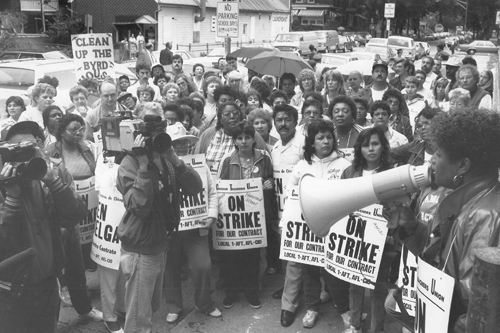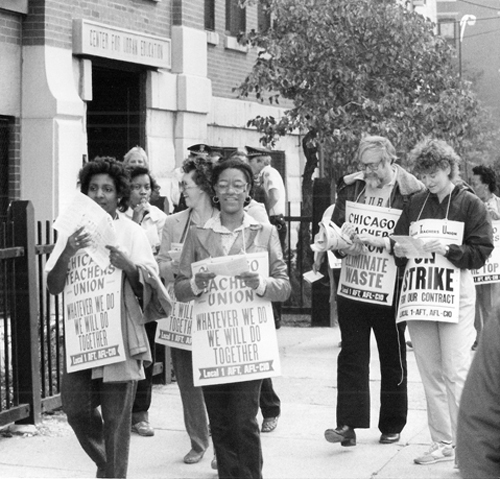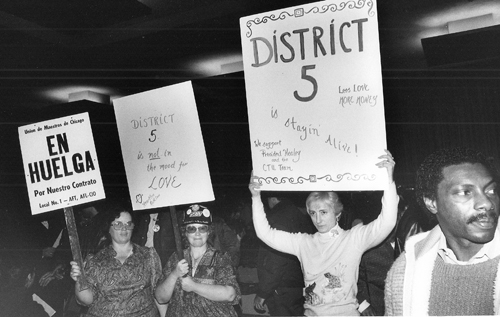STRIKEWATCH: Chicago Teachers Union orders printing of 'ON STRIKE...' signs in preparation for possible September 4 strike
Five days before a special meeting of the 800-member Chicago Teachers Union House of Delegates is scheduled to meet at Chicago's Lane Technical High School at which time the delegates from all of the city's schools could vote to start the ten-day clock ticking before a September 4, 2012 strike, the CTU announced on Friday, August 17, that it had ordered its printer to begin printing the famous ON STRIKE signs that union members have carried in every strike since the first one in 1969.
 The basic strike sign during the nine official Chicago Teachers Union strikes has read "ON STRIKE FOR OUR CONTRACT". Above, CTU President Jacqueline Vaughn (above right with the bullhorn) speaks to strikes at a South Side picket line during the 19-day strike in September 1987. The hand-made sign in the rear (left) was typical of the kinds of opinions teachers expressed during the strikes. "Clean up the Byrd House..." refers to Manford Byrd who was, in 1987, General Supt. of Chicago's public schools. In a press release issued at noon on August 17, the union reported as follows:
The basic strike sign during the nine official Chicago Teachers Union strikes has read "ON STRIKE FOR OUR CONTRACT". Above, CTU President Jacqueline Vaughn (above right with the bullhorn) speaks to strikes at a South Side picket line during the 19-day strike in September 1987. The hand-made sign in the rear (left) was typical of the kinds of opinions teachers expressed during the strikes. "Clean up the Byrd House..." refers to Manford Byrd who was, in 1987, General Supt. of Chicago's public schools. In a press release issued at noon on August 17, the union reported as follows:
"Contract Talks Continue; Strike Signs Being Printed
"CHICAGO – Labor negotiations between the Chicago Teachers Union and Chicago Public Schools continue, but in the meantime, the union says it must prepare its members for the worst. 'On Strike' protest signs are currently being printed, although no decision has been made whether or not teachers, school clinicians and paraprofessionals will issue a work stoppage in coming days. State law requires the Union to give a 10-day notice before a strike. 'We do not want to strike,' said CTU President Karen Lewis, 'but if we cannot reach an agreement we might. We cannot wait until the day of a strike to print signs and prepare over 25,000 members for a work stoppage. We have to be ready one way or another. We will do what we have must to ensure our rights are respected and our students get what they deserve.'
 The basic sign reading ON STRIKE FOR OUR CONTRACT was not the only sign carried by union members during the nine official CTU strikes between 1969 and 1987. Other signs, as in the above photograph from the 1983 strike, read "Whatever we do we will do together...", "Eliminate Waste..." and (in the rear right, barely visible) "Chop the Top..." The strikers in the above photograph are picketing at the Center for Urban Education at 160 W. Wendell St. (across Wells St. from the current Payton High School) and singing songs from the "Songs for Strike and Struggle" song book produced by Substance.The union also announced that members of the media could get access to the printing plant where the signs are being printed in the same press release, an unusual move that is unprecedented in CTU history. "Progress Printing, 3324S. Halsted, (Ask for Nina at 773-927-0123)..." the CTU press release continued.
The basic sign reading ON STRIKE FOR OUR CONTRACT was not the only sign carried by union members during the nine official CTU strikes between 1969 and 1987. Other signs, as in the above photograph from the 1983 strike, read "Whatever we do we will do together...", "Eliminate Waste..." and (in the rear right, barely visible) "Chop the Top..." The strikers in the above photograph are picketing at the Center for Urban Education at 160 W. Wendell St. (across Wells St. from the current Payton High School) and singing songs from the "Songs for Strike and Struggle" song book produced by Substance.The union also announced that members of the media could get access to the printing plant where the signs are being printed in the same press release, an unusual move that is unprecedented in CTU history. "Progress Printing, 3324S. Halsted, (Ask for Nina at 773-927-0123)..." the CTU press release continued.
CTU members have held nine union strikes and one additional 'wildcat' strike since the union first won collective bargaining rights in 1967. Union members generally trace all of the gains in both pay and benefits, on the one hand, and working conditions, on the other, to the union's willingness to strike. For years, the union's slogan was "Collective bargaining, not collective begging." It was only after the union stopped striking following the 19-day strike in 1987 that the Board of Education began to roll back not only the union members' economic gains, but also the ability of union members to enforce decent learning conditions for the children in the city's more than 600 public schools.
The union's contractual powers did not only cover wages, hours, and fringe benefits, despite recent propaganda from corporate school reform groups, which have promoted the idea that the union contract should only deal with the bare bones of pay and benefits and forbid teachers from using the contract to make educational decisions to improve learning conditions in the schools. The current Board of Education's contract position at the beginning of negotiations in 2011, according to union officials (see Kristine Mayle's speech to the May 23 rally at the Auditorium Theatre, in Back Issues, May 2012 at substancenews.net), was that the contract should be gutted and reduced to only a handful of pages. Since the negotiations began, the current union leadership has demanded that the Board include class size and other key issues in the negotiations, but as late as August 2012 the Board has refused, and the public has been deprived of that information by Chicago's corporate media, which view the power to raise class sizes to as high as 40 or 50 as what is called a "management prerogative."
 Although the union continued to utilize a basic ON STRIKE sign during the 20 years of militancy that began in the 1960s, by the 1980s, strike signs were printed in Spanish as well as in English. Union officials have always tried to encourage union members to stay "on message" during a strike, but as strikes continue the signs created by teachers became more and more creative. Above, the middle sign, during the 1983 strike, reads: "District 5 is not in the mood for Love..." referring to then General Supt. of Schools Ruth B. Love.Prior to 1995, union delegates at the city's public schools had the power to enforce class size maximums through contract grievances, for example. After the passage of the Amendatory Act of 1995 (which was supported by some Democrats, including Chicago Mayor Richard M. Daley, but not most), the union was stripped of its contract powers in many areas, including class sizes. One result, according to union activists and historians (including this reporter) was that by 2012, the Board of Education was able to force teachers to have class sizes of more than 40 students, despite guidelines that state that maximum class sizes in most classes are supposed to be 28.
Although the union continued to utilize a basic ON STRIKE sign during the 20 years of militancy that began in the 1960s, by the 1980s, strike signs were printed in Spanish as well as in English. Union officials have always tried to encourage union members to stay "on message" during a strike, but as strikes continue the signs created by teachers became more and more creative. Above, the middle sign, during the 1983 strike, reads: "District 5 is not in the mood for Love..." referring to then General Supt. of Schools Ruth B. Love.Prior to 1995, union delegates at the city's public schools had the power to enforce class size maximums through contract grievances, for example. After the passage of the Amendatory Act of 1995 (which was supported by some Democrats, including Chicago Mayor Richard M. Daley, but not most), the union was stripped of its contract powers in many areas, including class sizes. One result, according to union activists and historians (including this reporter) was that by 2012, the Board of Education was able to force teachers to have class sizes of more than 40 students, despite guidelines that state that maximum class sizes in most classes are supposed to be 28.

